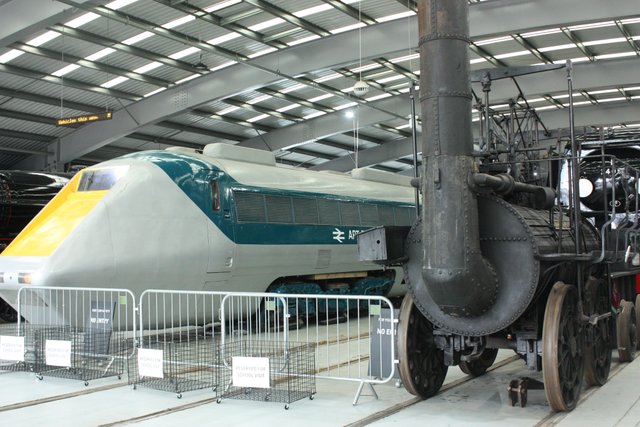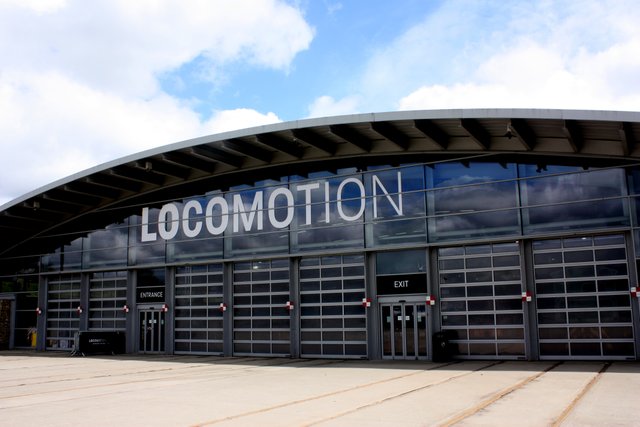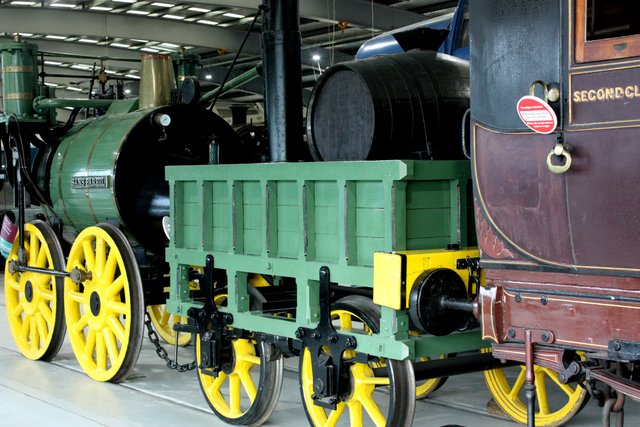The start of the railways
What have the railways ever done for us? It’s a question that has almost certainly never been asked in Darlington and Shildon.
Shildon can justifiably claim to be the world’s first railway town as on 27th September 1825 a journey was made from Shildon to Stockton via Darlington. The steam engine Locomotion pulled over thirty wagons containing passengers and coal, sometimes together in the same waggon, for about 5 hours over a distance of around 25 miles. There were some stoppages as aa wagon broke a wheel and had to be detached from the train and the locomotive needed repairs soon afterwards for about 35 minutes. A man fell off one of the wagons and was run over by the next wagon in line. He broke his foot. Coal from some of the wagons was distributed to the poorer people of Darlington at a scheduled stop
The Locomotion Museum at Shildon is part of the National Railway Museum at York and the Science Museum in London. It’s clearly visible on the left-hand side of the tracks just before Shildon if you’re travelling to Bishop Auckland from Darlington. The list of stations for this service includes Railway Museum, so there’s little excuse to miss the gigantic aircraft-hangar sized building housing the locomotives, carriages, and waggons of Locomotion. This word is emblazoned under the crescent-shaped roof of the entrance.
Outside the building are various engines and carriages displayed on sidings as though they’re not important enough to be inside. Entrance to Locomotion is free although there is a suggested donation, which I would encourage visitors to pay as it keeps these museums open throughout the year.
Inside it’s difficult to know where to start as there are locomotives, carriages, tenders, milk waggons, hoppers, advanced passenger trains, and models of old steam engines lined up on parallel lines. Particularly striking is the positioning of an Advanced Passenger Train (APT) on a track next to an early locomotive, a model of Locomotion, the first locomotive in the world to pull a passenger train. There’s also a beautiful yellow and green full-size model of the Sans Pareil locomotive. The original built by Timothy Hackworth took part in the Rainhill Trials in 1829.

Other highlights of the Locomotion collection include a massive, powder-blue English Electric diesel, a LNER snow-plough, and a Siphon G Waggon first used before WWII for distributing milk. It has the immortal words “Shunt with Care” stencilled on the side. During the war, this waggon served as an ambulance and then served as a parcel carrier and a generator vehicle afterwards. Nearby are carriages in LMS livery, sections of the Royal Train, a hopper for carrying grain, and a national benzole oil tank waggon.
The shop sells railway memorabilia, T-shirts, and models. The cafe has filling food and drinks, plus some of the seating is from an actual train, I think Eurostar which is quite an imaginative idea.
In Darlington, the Head of Steam Museum is altogether a more intimate place, but is not an easy place to find, especially if you’re travelling by train like me. I arrived from Newcastle and assumed the main station of the first railway company in the world to use steam trains to haul passengers to their destinations would be signposted, but it wasn’t. I headed out of the station to the taxi rank and still there were no signs. I decided to head into the centre of town and see what I could find. As I was admiring St Cuthbert’s church I spotted a road sign to the Head of Steam museum and headed in that general direction, past the lovely clock tower and the underpass with its happy buskers. Head of Steam is probably 20 minutes away on foot from the modern day station, but it is worth seeking out.
The Head of Steam Museum is housed in the former North Road station. There is an entrance fee for the museum. This place not only provides a fascinating insight into the history of the railways, but also an indication of the history of Victorian times, showing that rail travel was equally popular with all levels of society. In its heyday in the 19th Century around 80 people worked at the station in various service capacities. There were 7 grades of employee ranging from trainee through to manager. In the 1860s the station had its own police superintendent to maintain order and civility. First-class passengers had a separate entrance to the station and their own refreshment facilities and lavatory. There was a separate waiting room for ladies.
The main attraction at the Head of Steam is the locomotive Locomotion. This is not a model or a replica, it is the original locomotive although certain parts have been replaced over the years, such as the boiler, the original of which exploded in 1828 after the driver weighted down the safety valve to increase pressure - never a good idea. The driver paid the ultimate price for this act of silliness. This loco was built at the George Stephenson works in Newcastle in 1825 and saw service until 1850 when it was reduced to pumping duties at a local colliery. In 1857, Locomotion was retired and given to the Stockton and Darlington railway being placed on display at various stations in the area until it reached its current location in 1975. If you look closely, you will see there were no brakes on the locomotive, the idea being that shutting off the steam would slow down this beast of 11 tons 5 hundredweight.
Locomotion is the first in a line of four local locomotives on display allowing the visitor to appreciate how quickly the design and layout of steam trains changed in a short time. The locomotive next to Locomotion, named Derwent, was built in 1845 and has smooth, sleek lines based on a design of Timothy Hackworth, the man who built Sans Pareil for the Rainhill Trials of 1829. Derwent’s cylinders are almost horizontal and this locomotive has two tenders, one for water and one for coal, enabling heat from the fire to pass through the boiler twice. Derwent worked on the railways until 1869. The next locomotive, 1463 - Tennant class, was built in 1885 in Darlington, and pulled passenger trains between York and Newcastle before being retired for preservation in 1927. Most of the working parts on this locomotive are either hidden out of sight in or are operated from the driver’s cab. The final locomotive is a powerful heavy goods locomotive, 901 - Q7 class, which served from 1919 to 1962 hauling iron ore from the Tyne Dock at South Shields to the steel plant at Consett.
Other items worthy of mention include some huge wooden dog’s heads from the Tubwell Row collection in Darlington, a wall of train numbers, and a collection of railway posters encouraging holidaymakers to use the train to see the sights, the latter reminding me that I had to return to the main station to catch the train to Durham.


Congratulations @julianworker! You received a personal award!
Click here to view your Board of Honor
Congratulations @julianworker! You received a personal award!
You can view your badges on your Steem Board and compare to others on the Steem Ranking
Vote for @Steemitboard as a witness to get one more award and increased upvotes!